2013 Peugeot 508 Hybrid warning
[x] Cancel search: warningPage 212 of 340
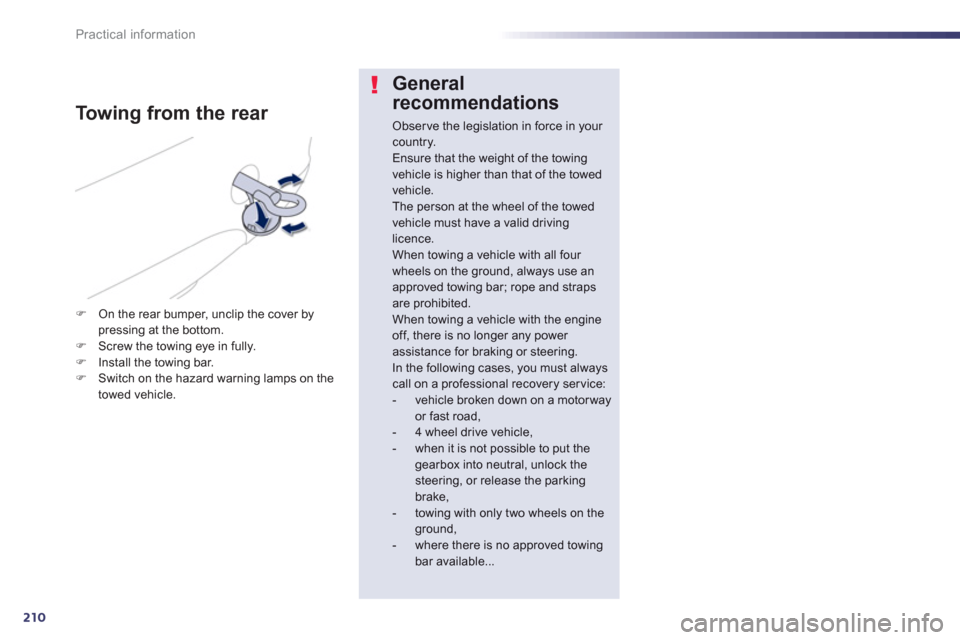
210
Practical information
General
recommendations
Observe the legislation in force in your country.Ensure that the weight of the towing vehicle is higher than that of the towedvehicle.The person at the wheel of the towedvehicle must have a valid driving licence.When towing a vehicle with all four wheels on the ground, always use an approved towing bar; rope and straps are prohibited. When towing a vehicle with the engine off, there is no longer any power assistance for braking or steering.In the following cases, you must always call on a professional recovery service:- vehicle broken down on a motor wayor fast road,
- 4 wheel drive vehicle, - when it is not possible to put the gearbox into neutral, unlock thesteering, or release the parkingbrake, - towing with only two wheels on theground, - where there is no approved towing bar available...
To w i ng from the rear
FOn the rear bumper, unclip the cover by pressing at the bottom. FScrew the towing eye in fully. FInstall the towing bar.FSwitch on the hazard warning lamps on the
towed vehicle.
Page 214 of 340

212
Practical information
Driving advice
Distribution of loads
FDistribute the load in the trailer so that theheaviest items are as close as possible to
the axle and the nose weight approaches
the maximum permitted without
excee
ding it.
Air density decreases with altitude, thus reducingengine performance. Above 1 000 metres, the maximum towed load must be reduced by 10 %
for every 1 000 metres of altitude.
Side wind
FTake into account the increased sensitivity
to side wind.
Cooling
To w i ng a trailer on a slope increases the
temperature of the coolant.
As the fan is electricall
y controlled, its cooling capacity is not dependent on the engine speed.
F
To lower the engine speed, reduce your speed.
The maximum towed load on a long incline
depends on the
gradient and the ambient
temperature.
In all cases, keep a check on the coolant
temperature.
FIf the warning lamp and the
STOP warning lamp come on, stop the vehicle and switch off
the engine as soon as possible.
Braking
To w i ng a trailer increases the braking distance.
To avoid overheating of the brakes on a longmountain type of descent, the use of engine braking is recommended.
Tyres
F
Check the tyre pressures of the towingvehicle and of the trailer, obser ving the recommended pressures.
Lighting
F
Check the electrical lighting and signalling on the trailer.
The rear parking sensors will be deactivated automatically if a genuine PEUGEOT towbar is used.
R
efer to the "Technical Data" section for details
of the weights and towed loads which apply to your vehicle.
Page 216 of 340
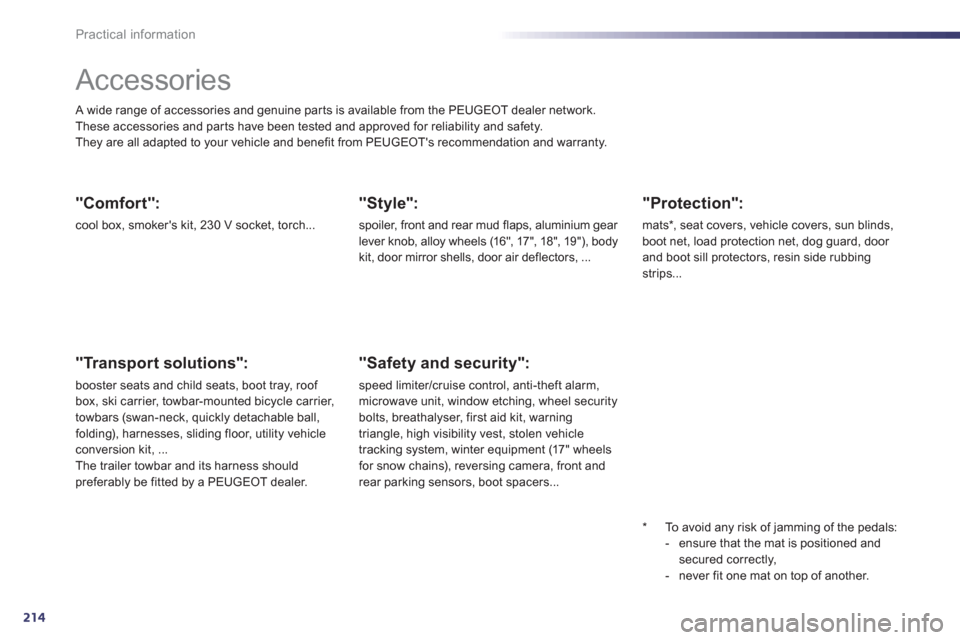
214
Practical information
Accessories
A wide range of accessories and genuine par ts is available from the PEUGEOT dealer network.
These accessories and par ts have been tested and approved for reliability and safety.
They are all adapted to your vehicle and benefit from PEUGEOT's recommendation and warranty.
"Comfort":
cool box, smoker's kit, 230 V socket, torch...
"Transport solutions":
booster seats and child seats, boot tray, roof
box, ski carrier, towbar-mounted bicycle carrier,
towbars (swan-neck, quickly detachable ball, folding), harnesses, sliding floor, utility vehicleconversion kit, ...
The trailer towbar and its harness shouldpreferably be fitted by a PEUGEOT dealer.
"Style":
spoiler, front and rear mud flaps, aluminium gear lever knob, alloy wheels (16 ", 17 ", 18 ", 19 "), body kit, door mirror shells, door air deflectors, ...
*
To avoid an
y risk of jamming of the pedals:
- ensure that the mat is positioned and
secured correctl
y,
- never fit one mat on top of another.
"Safety and security":
speed limiter/cruise control, anti-theft alarm,
microwave unit, window etching, wheel securitybolts, breathalyser, first aid kit, warningtriangle, high visibility vest, stolen vehicle
tracking system, winter equipment (17" wheels for snow chains), reversing camera, front andrear parking sensors, boot spacers...
"Protection":
mats *
, seat covers, vehicle covers, sun blinds,boot net, load protection net, dog guard, door
and boot sill protectors, resin side rubbingstrips...
Page 217 of 340
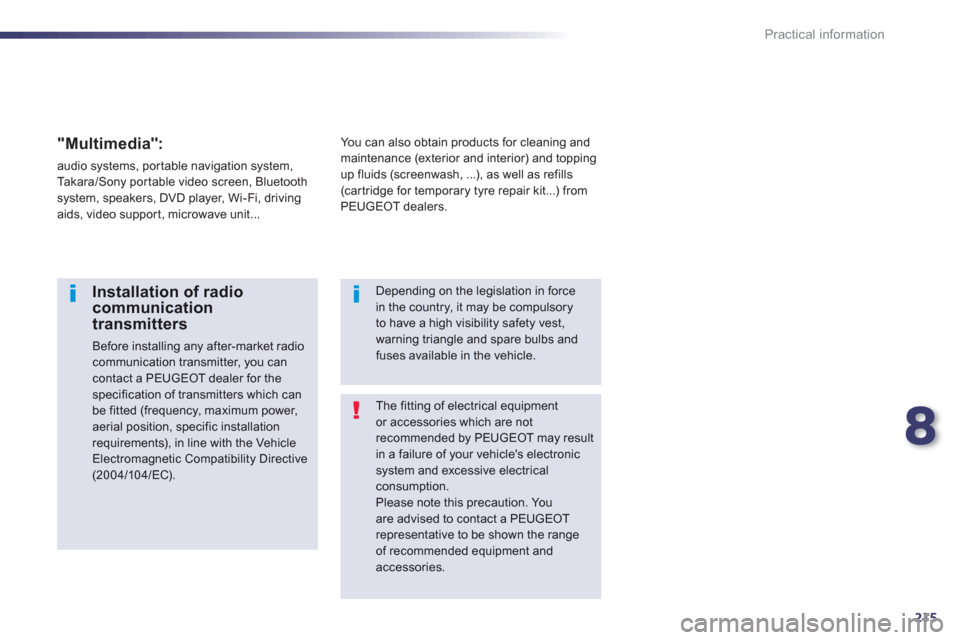
8
215
Practical information
The fitting of electrical equipmentor accessories which are notrecommended by PEUGEOT may result in a failure of your vehicle's electronic system and excessive electricalconsumption.Please note this precaution. You are advised to contact a PEUGEOT representative to be shown the rangeof recommended equipment andaccessories.
Installation of radio communication transmitters
Before installing any after-market radio communication transmitter, you can contact a PEUGEOT dealer for the specification of transmitters which canbe fitted (frequency, maximum power, aerial position, specific installation
requirements), in line with the VehicleElectromagnetic Compatibility Directive(2004/10 4/EC).
Depending on the legislation in force in the country, it may be compulsoryto have a high visibility safety vest, warning triangle and spare bulbs and fuses available in the vehicle. You can also obtain products
for cleaning and
maintenance (exterior and interior) and topping up fluids (screenwash, ...), as well as refills(cartridge for temporary tyre repair kit...) fromPEUGEOT dealers.
"Multimedia":
audio systems, portable navigation system,
Ta k a r a / S o ny por table video screen, Bluetoothsystem, speakers, DVD player, Wi-Fi, drivingaids, video suppor t, microwave unit...
Page 226 of 340
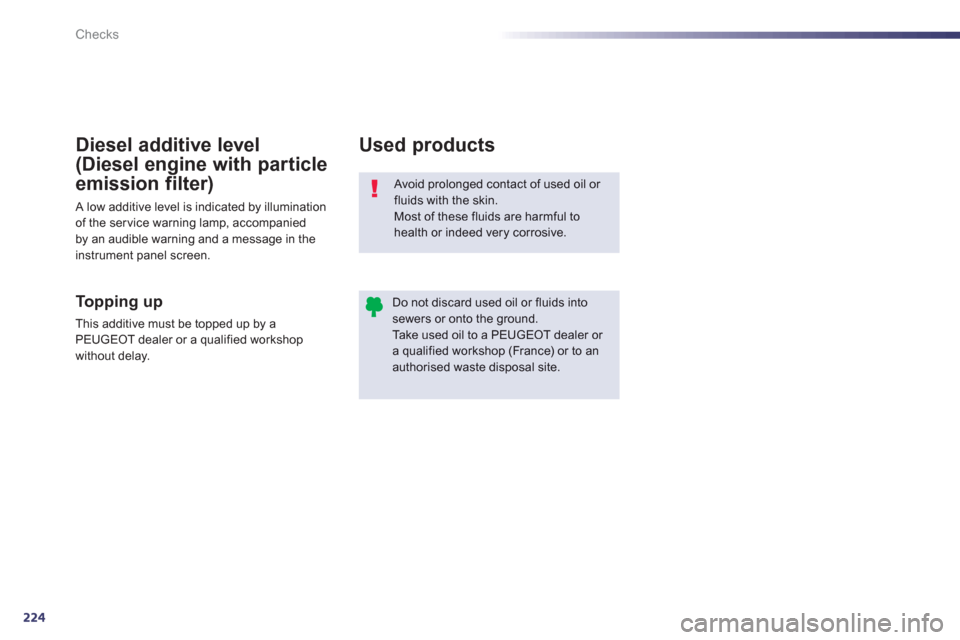
224
Checks
Avoid prolonged contact of used oil or fluids with the skin. Most of these fluids are harmful to
health or indeed very corrosive.
Do not discard used oil or fluids intosewers or onto the ground. Take used oil to a PEUGEOT dealer or a qualified workshop (France) or to an authorised waste disposal site.
Used products
To p p i ng up
This additive must be topped up by a
PEUGEOT dealer or a qualified workshop
w
ithout delay.
Diesel additive level
(Diesel engine with particle
emission filter)
A low additive level is indicated by illumination
of the ser vice warning lamp, accompanied by an audible warning and a message in the
instrument panel screen.
Page 227 of 340
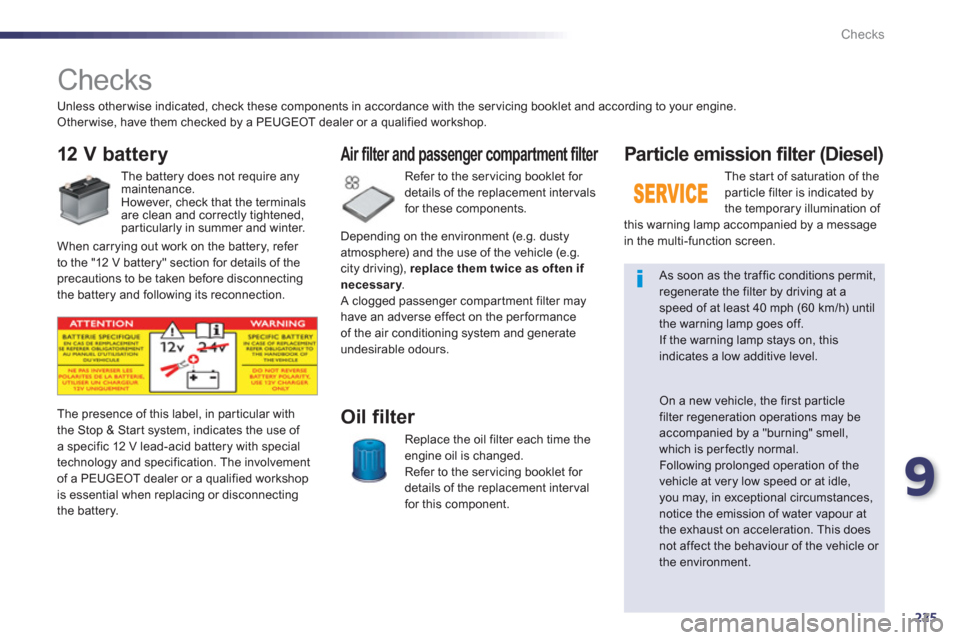
9
225
Checks
Checks
12 V battery
The battery does not require anymaintenance.
However, check that the terminals
are c
lean and correctly tightened,
particularly in summer and winter.
Refer to the servicin
g booklet for
details of the replacement inter vals
for these components.
Air filter and passenger compartment filter
Replace the oil filter each time theengine oil is changed.
Refer to the servicing booklet for
details of the replacement inter val
for this component.
Oil filter The presence of this label, in par ticular with
the Stop & Star t system, indicates the use of
a specific 12 V lead-acid battery with special
technology and specification. The involvement
of a PEUGEOT dealer or a qualified workshop
is essential when replacing or disconnecting
the battery.
Par ticle emission filter (Diesel)
The start of saturation of thepar ticle filter is indicated by
the temporary illumination of
this warning lamp accompanied by a message
in the multi-function screen.
As soon as the traffic conditions permit, regenerate the filter by driving at aspeed of at least 40 mph (60 km/h) until the warning lamp goes off.
If the warning lamp stays on, thisindicates a low additive level.
On a new vehicle, the first particlefilter regeneration operations may beaccompanied by a "burning" smell,which is perfectly normal.
Following prolonged operation of thevehicle at very low speed or at idle, you may, in exceptional circumstances, notice the emission of water vapour atthe exhaust on acceleration. This does not affect the behaviour of the vehicle or the environment.
Unless other wise indicated, check these components in accordance with the ser vicing booklet and according to your engine.
Other wise, have them checked by a PEUGEOT dealer or a qualified workshop.
When carr
ying out work on the battery, refer
to the "12 V battery" section for details of theprecautions to be taken before disconnecting
the battery and following its reconnection.Dependin
g on the environment (e.g. dustyatmosphere) and the use of the vehicle (e.g.city driving), replace them twice as often if necessary.y A clogged passenger compartment filter may have an adverse effect on the performance
of the air conditioning system and generateundesirable odours.
Page 230 of 340

228
Technical data
*
The kerb weight is equal to the unladen weight + driver (75 kg). **
The weight of the braked trailer can be increased, within the GTW limit, if the GVW of the towing vehicle is reduced by an equal amount; warning,
towing using a lightly loaded towing vehicle may have an adverse effect on its road holding.
Petrol weights and towed loads (in kg)
The GTW and towed load values indicated are valid up to a maximum altitude of 1 000 metres; the towed load mentioned must be reduced by 10 % for each additional 1 000 metres of altitude.
The speed of a towing vehicle must not exceed 60 mph (10 0 km/h) (comply with the legislation in force in your country).
High ambient temperatures may result in a reduction in the performance of the vehicle to protect the engine; if the ambient temperature is above 37 °C,
limit the towed load.
Petrol engines1.6 litre V Ti120 hp1.6 litre THP156 hp
GearboxesElectronic gear control(6-speed)
Manual(6-speed)
Automatic(6-speed)
Model codes
8D5FH8/P - 8E5FH8/P 8D5FS8/P - 8E5FS8/P 8D5FV8 - 8E5FV8
8D5FNA - 8E5FNA 8D5FVA - 8E5FVA
BodySaloon
SW
Saloon SW
Saloon
SW
- Unladen wei
ght 1 390
1 410
1 400
1 420
1 410
1 430
- Kerb weight *
1 465 1 485
1 475 1 495
1 485
1 505
- Gross vehicle wei
ght (GV W)
1 945 2 0551 9952 080
2 015 2 10 0
- Gross train weight (GTW)
on a 12 % gradient 3 3453 355
3 595
3 5803 515
3 600
- Braked trailer
(within GTW limit) on a 10 % or 12 % gradient1 400
1 3001 6001 500
1 600
1 500
- Braked trailer ** (with load transfer within the
GTW limit) 1 675 1 575 1 875 1 7751 875 1 775
-
Unbraked trailer
730
740735
745
740
750
- Recommended nose weight 7575
Page 231 of 340

10
229
Technical data
Petrol engine1.6 litre THP 160 hp
Gearbox
Manual(6-speed)
Model code
-
Body
Saloon
SW
- Unladen wei
ght -
-
- Kerb weight
*-
-
- Gross vehicle wei
ght (GV W)
-
-
-
Gross train weight (GTW)
on a 12 % gradient --
- Braked trailer (within GTW limit) on a 10 % or 12 % gradient--
- Braked trailer ** (with load transfer within the
GTW limit) -
-
-
Unbraked trailer --
- Recommended nose weight
-
*
The kerb weight is equal to the unladen weight + driver (75 kg). **
The weight of the braked trailer can be increased, within the GTW limit, if the GVW of the towing vehicle is reduced by an equal amount; warning,
towing using a lightly loaded towing vehicle may have an adverse effect on its road holding.
Petrol weights and towed loads (in kg)
The GTW and towed load values indicated are valid up to a maximum altitude of 1 000 metres; the towed load mentioned must be reduced by 10 % for each additional 1 000 metres of altitude.
The speed of a towing vehicle must not exceed 60 mph (10 0 km/h) (comply with the legislation in force in your country).
High ambient temperatures may result in a reduction in the performance of the vehicle to protect the engine; if the ambient temperature is above 37 °C,
limit the towed load.